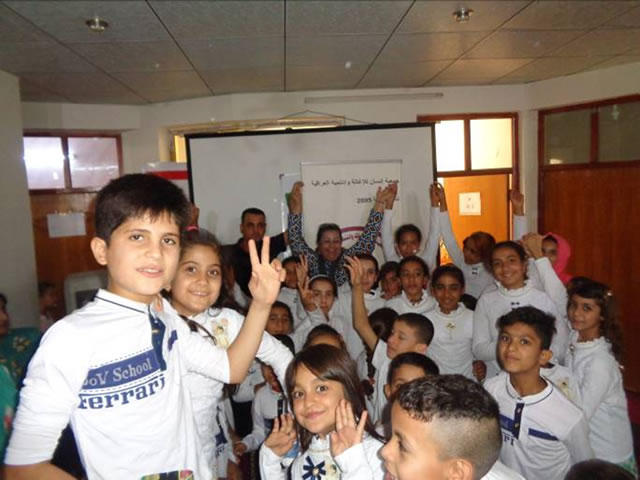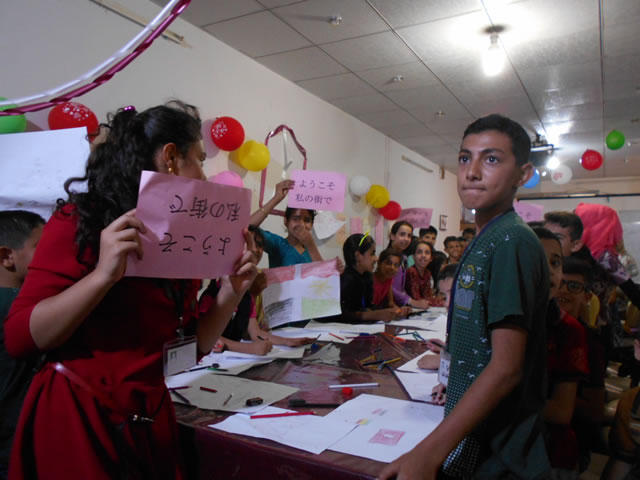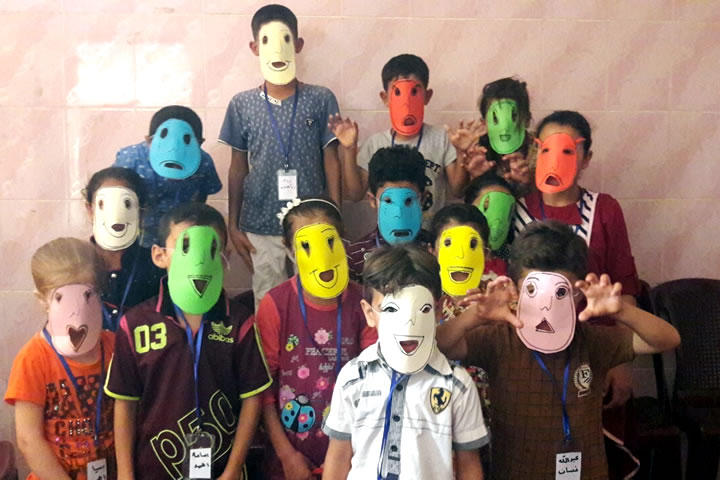[Original by Ghamra Rifai, Volunteer of the Iraq Project Team and Emi Nakano, Assistant of the Iraq Project Team (6 March 2018); Translated by M. Kanai/R. Florea]
Here is the report on the activities of ‘Peace Yard’implemented jointly by INSAN (Iraqi Society for Relief and Development) and JVC from August to October 2017.
1. Selection of participants
In five districts including Rapareen in Kirkuk City, we approached the parents of children who were not attending school and called for participation in our Social Art Workshop. We had a meeting with the parents, explained our activities, and tried to obtain detailed information about the participating children. In cooperation with the INSAN community committee, we also informed the residents of the targeted districts about our workshop utilizing flyers and banners.
Breakdown of the participants (65 in total)
| Girls: 40 | Boys: 25 | ||
| Arabs: 50 | Kurds: 10 | Turkmens: 5 | |
| 65 in total |
2. Transportation by bus
Considering poor security condition, we provided bus transportation services to ensure the safety of children. A 25-seat bus made two trips collecting 65 children from the five districts.
3. Implementation of the Program
We implemented 10 art sessions at Peace Yard in the building where INSAN has its office. In addition we implemented four field trips. Each session lasted three hours (two hours for art session and one hour for mental care by a psychiatrist). Experts of peace and human rights conducted the sessions together with art social workers of INSAN’s staff. Volunteers of INSAN supported the sessions and a psychiatrist provided mental care.
The main contents of the program were:
| Aug.15 | ①Raising awareness of peace building ②Introduction of each child with her/his profile |
| Aug.23 | ①Presentation using a mask (Children freely expressed their opinions wearing a mask) ②Message for Peace (Sitting in a circle with eyes closed, children conveyed their greetings and wishes for peace by touching hands each other) |
| Aug.29 | ①Depicting peace by drawing a picture or making handicraft items (Arab and Kurds children drew a picture of national flag of each other’s country) ②Children welcomed JVC Staff from Japan using cards written in Japanese |
| Aug.31 | Watching a video on the theme ‘Believe in and take care of oneself’ followed by a psychiatrist’s talk |
| Oct. 2 | Visit to Children’s Anemia Center (Giving help to sufferers irrespective of ethnic or religious differences. Children made a donation out of their pocket money) |
| Oct. 4 | Making lyrics on the theme of peace and singing together |
| Oct. 7 | Learning Japanese culture (geography, history, foods, clothing, characters, and so on) |
| Oct. 8 | ①Visit to an orphanage (Playing with orphans and explaining about the meaning of peace) ②Playing games and singing songs at an amusement park |
| Oct. 9 | Creating a piece of work by imagining what a lovely garden is like and naming it ‘Peace Yard’ |
| Oct.10 | Visit to a home for elderly people (Helping home’s staff and listening to the elderlies) |
| Oct.11 | Role Playing on the theme of Conflict Resolution. Through the short play, children learned the importance of dialogue and at the same time acquired basic knowledge concerning theatrical performance such as play, stage, scenario, characters, director and audience. |
| Oct.14 | ①Reading cartons on solidarity and peaceful coexistence among community members and having discussions. ②Watching a video on how to express the image of peace and human rights in drawings |
| Oct.15 | Reading to children a story on peaceful coexistence (A facilitator read a story and asked their opinions on the subject) |
- For each session, social workers observed children’s reactions and feedback and gave a proper response as required.
- A psychiatrist joined the sessions, observed the children’s reactions and took appropriate measures as required.
- During every session, children were served with juice and sweets.
An example: the case of Hadeel
Due to the military occupation by the “Islamic State”, Hadeel, an eleven-year-old girl, fled from Hawija and came to Rapareen in Kirkuk city for refuge. The experience of bombings at home was so shocking that she became afraid of going out and subsequently quit school. Her parents tried to persuade her in vain to go back to school.
In July 2017, an INSAN social worker met Hadeel while visiting refugees, and made arrangements for her and her parents to meet a psychiatrist. After receiving counseling from the psychiatrist several times and getting warm encouragement by the social worker, she has become able to go to school.



